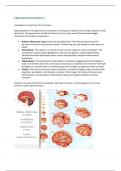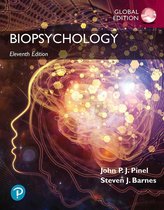Neuroscience lecture 1
Cerebellum is extension of the surface.
Big cerebellum in the goose is for movement, so the goose needs to have a big cerebellum to be
able to fly. The goose has a smaller forebrain, so it isn’t very smart. Humans have bigger
forebrains and smaller cerebellums.
Bulbus olfactorius biggest part of a rat/rabbit brain. The olfactory bulb is a brain
structure involved in the sense of smell rabbit and rats rely heavily on their sense of
smell.
Cerebellum: This region is crucial for motor control, balance, and coordination. The
cerebellum is particularly highlighted in the cat and dolphin, indicating that these
animals have well-developed motor control and possibly complex movements or
behaviours.
Whole Brain: The whole brain of the dolphin is featured, suggesting that the dolphin's
brain is of interest due to its overall size and structure. Dolphins are known for their high
intelligence, and their brain is relatively large and complex compared to other animals.
Cortex: The cortex is the outer layer of the brain, involved in higher-order functions like
cognition, perception, and decision-making. In the image, the cortex of humans and
chimpanzees is emphasized, reflecting the advanced cognitive abilities of these
primates.
Dolphin: one part of the brain is sleeping, other part is active. It needs oxygen but can only
achieve it when above surface.
,Trepanation: a surgical intervention in which a hole is drilled or scraped into the human skull.
The intentional perforation of the cranium exposes the dura mater. The function was to:
- Kill or cure
- Use for therapy
- Exorcising evil spirits
Hippocrates:
1. Correlation between Structure and Function: Hippocrates, often considered the
"Father of Medicine," emphasized the relationship between the physical structure of the
body and its function. He believed that understanding the anatomy of the body could
explain how it functions and that the brain's structure played a key role in its functions.
2. The Brain as the Organ of Sensation: Hippocrates proposed that the brain is the central
organ responsible for sensation. He believed that the eyes, ears, nose, and tongue were
connected to the brain via nerves, making the brain the organ that processes sensory
information.
3. Site of Intelligence: Hippocrates argued that the brain is also the seat of intelligence,
reasoning, and thought. This idea was quite advanced for his time, as it recognized the
brain's role in cognitive functions.
Aristotle:
1. The Heart as the Intellectual Center: Aristotle, in contrast to Hippocrates, believed
that the heart was the center of intelligence and emotion. He saw the heart as the
source of intellect and considered it the most important organ in the body. This view was
rooted in the observation that emotions such as fear, love, and anger seemed to cause
physical sensations in the chest.
2. The Brain's Role in Cooling the Passions: Aristotle acknowledged the brain's existence
but believed its primary function was to cool the blood and temper the passions
generated by the heart. He thought that the cerebrospinal fluid (CSF) in the brain played
a role in this cooling process, rather than being involved in intellectual functions.
Mentalism:
- Philosophical position: Mentalism is the belief that behavior and mental processes are
governed by an immaterial mind, separate from the physical body. This view suggests
that the mind, rather than the brain or other physical structures, is the primary agent
responsible for thoughts, emotions, decisions, and actions.
- Mind/body problem: Mentalism is closely related to the "mind/body problem," a
fundamental question in philosophy and psychology that explores the relationship
between the mind and the body. The mind/body problem asks how an immaterial mind
can influence a physical body, or vice versa.
Galenus 130-200 AD
Galenus was a physician of the gladiators, in this way he gained experience in treating traumatic
injuries. He studied anatomy by dissecting animals. He identified that the cerebrum, the larger
and softer part of the brain, was associated with sensory functions. He reasoned that its
softness made it suitable for receiving sensory impressions. He also correctly associated the
cerebellum, the denser and harder part of the brain, with motor control and coordination. Galen
believed its firmness made it ideal for controlling muscles. The conclusions were correct, but it
was based on the solid vs soft, which are incorrect observations.
Vesalius 1514-1564 AD:
,Descartes:
Descartes theorized that the ventricles of the brain and the heart played a crucial role in bodily
functions.
- Dualism: Descartes is best known for his theory of dualism, the belief that the mind and
body are fundamentally distinct substances. He argued that the body is a physical
entity, subject to the laws of physics, while the mind (or soul) is a non-physical entity,
not bound by these laws. Despite their separate natures, Descartes believed that the
mind and body interact with each other.
- Body Functions Controlled by Body Fluids: Descartes believed that bodily functions
were controlled by the movement of fluids within the body. He theorized that "animal
spirits," a type of fine fluid or vapor, flowed through the nerves and were responsible for
movement and sensation. This idea was part of a broader view that the body operated
like a machine.
- Hydraulic System: Descartes compared the body's function to a hydraulic system, a
concept he borrowed from contemporary engineering. In such systems, fluids move
through pipes to create mechanical motion. Similarly, Descartes thought that animal
spirits moved through the nerves to control muscles and other organs, causing them to
contract or expand like hydraulic systems in machines.
- Royal Gardens (Diana/Neptunus): Descartes was inspired by the mechanical statues
and fountains in the Royal Gardens of Saint-Germain-en-Laye, near Paris. These gardens
featured elaborate waterworks, where statues of gods and goddesses like Diana and
Neptune were animated by hidden hydraulic mechanisms. For example, a statue of
Diana would appear to move when water was directed through certain pipes.
Benjamin Franklin: ‘Experiments and Observations on Electricity’
- Luigi Galvani: electrical stimulation of a frog’s nerve caused contraction
- Emil du Bois - Reymond: the brain generates electricity. Final replacement of the body
fluids theory
- Johannes Müller: doctrine of specific nerve energies (optic nerves - visual images).
- Pierre Florens: experimental ablation. Claimed the discovery of regions in the brain that
control heart rate and breathing, purposeful movements and visual and auditory
reflexes.
Take out part of the brain and look at the function that’s missing (experiments above).
Benjamin Franklin was an American polymath who was active as a writer, scientist, inventor,
statesman, diplomat, printer, publisher, and political philosopher. Among the leading
intellectuals of his time, Franklin was one of the Founding Fathers of the United States, a drafter
and signer of the Declaration of Independence, and the first postmaster general.
, Mouth is very sensitive, back for example is less sensitive
Prenology, skull shape and size. So bigger forehead means that part of the brain is more
developed better skills in that part. Franz Joseph Gall.
Cesare Lombroso:
relation between physical characteristics of the skull and the jaw (flat forehead, protrusive chin)
and criminal behaviour (homo delinquens)
amputation of the finger D3
function will go away is getting
picked up by D2 and D4 so you can
change brain function - plasticity in
the brain
amputated arm experiment:
amputated arm face took over.
People that have an amputated arm
can feel the tear from crying on their
amputated arm. The opposite of this





